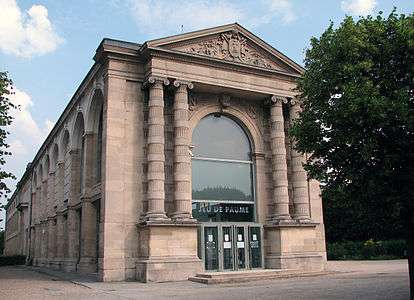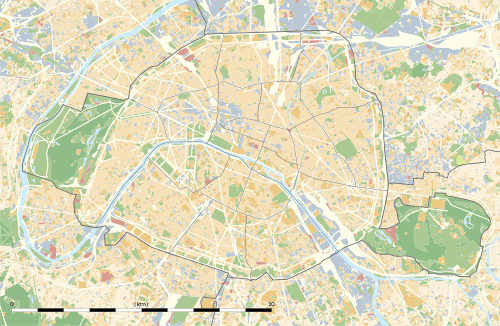Galerie nationale du Jeu de Paume
 Galerie nationale du Jeu de Paume | |
 Location within Paris | |
| Established | 1909 |
|---|---|
| Location | 1 Place de la Concorde, 1st arrondissement, Paris, France |
| Coordinates | 48°51′57″N 2°19′26″E / 48.86583°N 2.32389°E |
| Type | Art museum |
| Website | www.jeudepaume.org |
The Galerie nationale du Jeu de Paume is an arts centre for modern and postmodern photography and media. It is located in the north corner (west side) of the Tuileries Gardens next to the Place de la Concorde in Paris. In 2004, Galerie Nationale du Jeu de Paume, Centre National de la Photographie and Patrimoine Photographique merged to form the Association de Préfiguration for the Etablissement Public (EPIC) Jeu de Paume.[1]
History
The rectangular building was constructed in 1861 during the reign of Napoleon III. It originally housed real tennis courts; the name of this game in French is jeu de paume.
Nazi sorting house
Jeu de Paume was used from 1940 to 1944 to store Nazi plunder looted by the regime's Reichsleiter Rosenberg Taskforce (ERR) in France (see Rose Valland). These works included masterpieces from the collections of French Jewish families like the Rothschilds, the David-Weills, the Bernheims,[2][3] and noted dealers including Paul Rosenberg who specialised in impressionist and post-impressionist works.[4]
Hermann Göring commanded that the loot would first be divided between Adolf Hitler and himself. For this reason, from the end of 1940 to the end of 1942 he traveled twenty times to Paris. At Jeu de Paume, art dealer Bruno Lohse staged 20 expositions of the newly looted art objects, especially for Göring, from which Göring selected at least 594 pieces for his own collection; the rest was destined for the Führermuseum in Linz.
So called degenerate art (modern art "unworthy" in the eyes of the Nazis) was legally banned from entering Germany, and so once designated was held in what was called the Martyr's Room at the Jeu de Paume. Much of Paul Rosenberg's professional dealership and personal collection were subsequently so designated by the Nazis. Following Joseph Goebbels's earlier private decree to sell these degenerate works for foreign currency to fund the building of the Führermuseum and the wider war effort, Goering personally appointed a series of ERR-approved dealers including Hildebrand Gurlitt to liquidate these assets and then pass the funds to swell his personal art collection. With much of the looted degenerate art sold onwards via Switzerland, Rosenberg's collection was scattered across Europe. Unsold art (including works by Picasso and Dalí) was destroyed on a bonfire in the grounds of the Jeu de Paume on the night of 27 July 1942, an act of almost unparalleled vandalism. However, the Nazis had burned nearly 4000 works of German "degenerate" art in Berlin in 1939.
French resistance curator Rose Valland, who was working at the museum, kept a secret list of all the works passing through, and after the Nazi defeat in 1945 most of these works were thereby returned to their rightful owners.[2] Today, some 70 of Rosenberg's paintings are missing, including: the large Picasso watercolor Naked Woman on the Beach, painted in Provence in 1923; seven works by Matisse; and the Portrait of Gabrielle Diot by Degas.[4]
Post war museum
Between 1947 and 1986, it contained the Musée du Jeu de Paume, which held many important impressionist works now housed in the Musée d'Orsay. Widely considered as the "most famous museum of impressionist painting in the world",[5] the rooms bore names such as Salle Degas, Salle Cézanne, or Salle Monet.[6]
From 1989, as part of the Grands Projets of François Mitterrand, the building underwent a $10 million renovation by architect Antoine Stinco, resulting in about 12,700 square feet of exhibition space spread across three floors. The formerly walled-in reception hall was transformed into an atrium-like open area flooded with natural light from large bay windows, allowing views of the neighboring Tuileries Gardens, Place de la Concorde, and Eiffel Tower.[2] The top floor features a series of skylighted galleries.[7]
Present
In 1991, the Jeu de Paume reopened as "France's first national gallery of contemporary art",[6] with an exhibition devoted to Jean Dubuffet. Subsequent retrospectives were dedicated to international artists such as Marcel Broodthaers (1991), Robert Gober (1991),[8] Ellsworth Kelly (1992),[9] Helio Oiticica (1992), and Eva Hesse (1993). In 1999, the museum chose American architect Richard Meier as the subject of its first-ever architectural exhibition.[10] In 2004, Galerie Nationale du Jeu de Paume, Centre National de la Photographie and Patrimoine Photographique merged to form the Association de Préfiguration for the Etablissement Public (EPIC) Jeu de Paume.[1] It has since developed into a centre for modern and postmodern photography and media,[5] mounting survey exhibitions on Ed Ruscha (2006), Cindy Sherman (2006), Martin Parr (2009), and William Kentridge (2010), among others. In 2016 it will receive the anthological solo exhibition of contemporary photograph Helena Almeida.
Today the Jeu de Paume is subsidised by the French Ministry of Culture and Communication. Attendance increased from 200,000 visitors in 2006 to over 320,000 visitors in 2008.[11]
In popular culture
The museum's wartime history has been depicted, heavily fictionalized, several times on film. In John Frankenheimer's 1964 film The Train, starring Burt Lancaster and Jeanne Moreau, Rose Valland is represented as Mademoiselle Villard, played by Suzanne Flon.[2] In George Clooney's 2014 film The Monuments Men, Valland is represented as Claire Simone, played by Cate Blanchett. In Anatole Litvak's 1967 film The Night of the Generals, Peter O'Toole's character General Tanz, visits the museum and is transfixed by a self-portrait of Vincent van Gogh, referenced as "Vincent In Flames".
In Sara Houghteling's novel, Pictures at an Exhibition (2009), the character of Rose Clément is based on Rose Valland
The novel Portrait of a Woman in White, by Susan Winkler, about Nazi art looting in France, includes scenes in the Jeu de Paume with Hermann Goring and Rose Valland.
See also
References
- 1 2 "Jeu De Paume", Saatchi Gallery. Accessed 24 November 2014.
- 1 2 3 4 Hector Feliciano (10 July 1991), New Flair for Two Old Museums Los Angeles Times.
- ↑ Alan Riding (3 September 1997), Collector's Family Tries to Illuminate the Past of Manuscripts in France New York Times.
- 1 2 http://www.bonjourparis.com/story/the-lost-museum/
- 1 2 Eunice Lipton (4 January 2005), The youth of today The Guardian.
- 1 2 Ginger Danto (3 February 1991), For New Art, a Building Drenched in Art History New York Times.
- ↑ Michael Kimmelman (2 July 1991), A Paris Museum Reopens in a New Guise New York Times.
- ↑ Suzanne Muchnich (17 November 1991), An American Foot in the Door Los Angeles Times.
- ↑ John Russell (5 April 1992), Ellsworth Kelly, an American in Paris New York Times.
- ↑ Alan Riding (8 August 1999), Celebrating an Architect, Hailing an Artist New York Times.
- ↑ About the Jeu de Paume Official Website.
External links
| Wikimedia Commons has media related to Galerie nationale du Jeu de Paume. |
- Jeu de Paume
- The Jeu de Paume and the Looting of France – website of the Cultural Property Research Foundation, Inc.